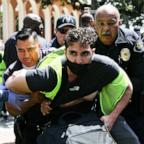Twin Gives Own Skin to Help Burned Sister
Jan. 5 -- The Cowan children have always been close, especially 7-year-old Sydney and Jenny, identical twin sisters. It was that closeness that saved Jenny's life.
An explosion in the fireplace of the girls' Alabama home just over a year ago left Jenny struggling for life.
Then 6 years old, she suffered burns over 80 percent of her body when she was transferred to Children's Hospital in Birmingham after the Dec. 8, 2002, accident. When Dr. William Hardin, a surgeon at the hospital, went to speak to her parents, he was worried that Jenny would not survive.
"Dr. Hardin had already, you know, come out and said, 'She's in very grave shape. We're just going to have to watch her and wait. We're not sure,'" said Sherri Cowan. "And I said 'I don't know what I'm going to do. What am I going to tell Sydney?'"
A Lightning Bolt
It was a question that gave Hardin a new idea.
"Sherri looked at me and said 'this is just going to kill her twin sister' and it was like a lightning bolt had hit me that potentially we might be able to use a twin as a donor of skin," Hardin said.
Jenny's wounds had to be covered with new skin as soon as possible, to prevent potentially deadly infections — but Jenny's new skin had to be an exact genetic match to her own. Most burn victims grow new skin in a laboratory, a process that can take months.
It was a race against time, and young Sydney was ready and willing to help her sick twin. Jenny had burns everywhere except on her head, her hands, behind her knees and under her arms.
"We kind of explained it to her on her terms that she could let her sister borrow her skin but she would never get it back," Sherri Cowan said. "And Sydney was ready to do it, that day. You know, ready, [saying] 'well, let's go.'"
Hardin, who performed the surgery, talked to experts nationwide and learned there had been other successful twin-to-twin skin grafts. But it was a difficult ethical decision because some feared that the operation would expose Sydney to unnecessary risks.




